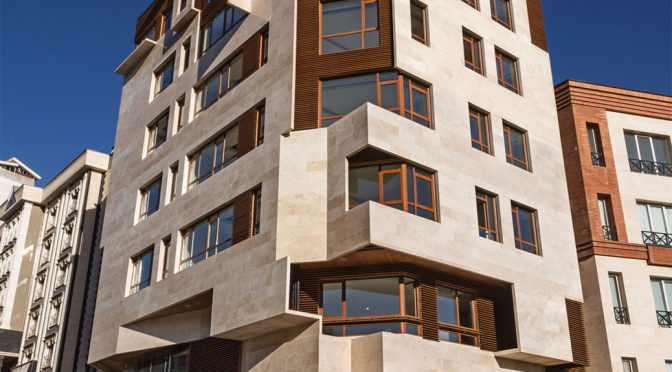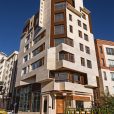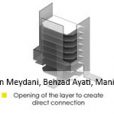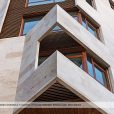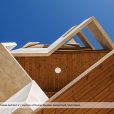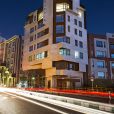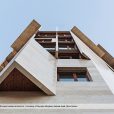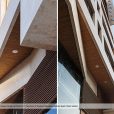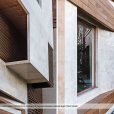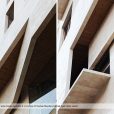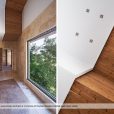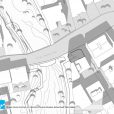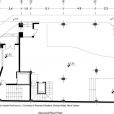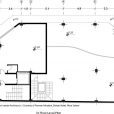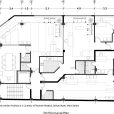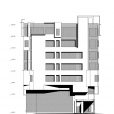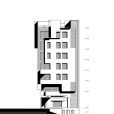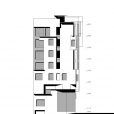ساختمان اداری ـ تجاری گروه سروین
پیمان میدانی، بهزاد آیتی، مانی سهام
راهیافته به مرحله نیمهنهایی سومین دوره جایزه شایستگی معمار ایرانی (۱۳۹۹)
موقعیت: تهران، ایران
تاریخ: ۱۳۹۲
مساحت: ۳۱۳۰ مترمربع
وضعیت: ساختهشده
کارفرما: آقای فرهاد جولانی
تیم پروژه: محبوبه یوسفیخواه، محسن حقپرست، پریهان رشیدی، مرضیه نبیزاده
ساختمان اداری ـ تجاری سروین در تقاطع خیابانهای ماکوییپور و بهزادی قرار گرفته است. موقعیت خاص این پروژه در کنار مسیل ولنجک (توچال) که به صورت فضای سبز شهری تعریف و بازسازی شده است، لزوم تمرکز طراحی بر ارتباط ساختمان با فضای خارج را تقویت میکند. ما در تلاش برای دستیابی به الگویی برای ارتباط فضای داخلی ساختمان با فضای خارجی یا شهر بودیم که بهترین برایند میان نیروهای موثر داخل و خارج را معرفی کند و قابلیت تسرّی در شهر و شکلدهی نماهای شهری را داشته باشد.

علاوه بر قرارگیری ساختمان در تقاطعی پرتردد، با محورهایی که دید از دور به ساختمان را ممکن میسازد، کاربری بنا به عنوان ساختمان اداری ـ تجاری و لزوم عیان بودن و ظهور خارجی آن، راه را در تقویت ارتباط داخل و خارج باز گذاشت تا بیان مفاهیم مورد نظر در بستری آزادتر اتفاق بیفتد. این الگو در قالب تجربهای فرمی، با استفاده از جزئیات خاص، برای دستیابی به راهکارهای نو در برقراری ارتباط بنا با شهر شکل گرفت و این ایده، توسط پوستهای مجزا از فضای داخلی بروز پیدا کرد. شکلگیری این پوسته بر پایه اصول منطقی و با در نظر گرفتن اصلیترین عوامل موثر بر فرم هر اثر معماری بوده است. در همین راستا، این عوامل در گروههای کلی “تمهیدات جوی”، “کاربری خاص (اداری ـ تجاری)” و “ارتباط بصری از و به شهر” تعریف شدند.

عمدهترین عامل شکلدهنده پوسته، دید مطلوب از داخل ساختمان به منظر شهری و طبیعی در زوایای خاص، و دید خارجی به ساختمان از محورهای مهم حرکت شهری در موقعیت بنا بوده است که بدنه اصلی را به وجود آورد. بخشهای داخلی در شکافهای پوسته، با تغییر در مصالح و استفاده از چوب به عنوان مظهری از زندگی ملموس درونی بروز داده شده است. این ترکیب خاص از سنگ در لایه خارجی و چوب در لایه داخلی پوسته معماری، از واژگان کلیدی طرح بوده است. یکی شدن فضای داخلی و خارجی در ورودی بنا، با تلفیق فرم و مصالح، به تداوم این ارتباط کمک میکند و این نقطه، مانند همه نقاط تماس بیرون و درون و حتی قویتر از سایر آنها، در حفظ این ارتباط میکوشد. موقعیتیابی ورودی در برنامهریزی طرح هم این نکته را در نظر داشته و به نحوی تعیین شده است که در نقطه اتصال بنا با طبیعت، از یک سو و شهر، از سوی دیگر باشد.
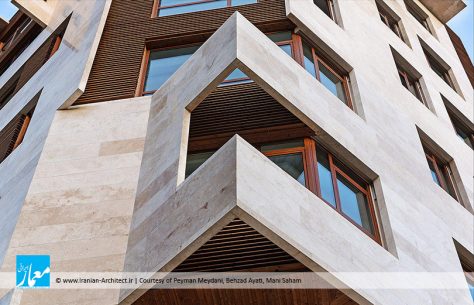
لزوم بروز خارجی و آشکارسازی در شهر برای کاربریهای اداری ـ تجاری نیز در تغییر فرم این پوسته تاثیر داشته و از طریق هماهنگسازی نشانهها و سطوح اطلاعرسانی با زوایای دید و حرکت ناظر، هم در حالت سواره و هم پیاده، معماری را به مقیاس انسانی آورده و ارتباط را در این تراز نیز حفظ کرده است. از میان عوامل جوی، حرکت باد که با توجه به موقعیت بنا در کنار رود دره شدت مییافت، در شکلدهی فرم پوسته در کنار پنجرههای طبقات بالا موثر بوده است. علاوه بر آن، وجود دید مطبوع در جبهه غربی و گشایش پوسته در این قسمت، نیاز به تعدیل نور غرب را حیاتی میساخت که باز با تغییر فرم پوسته ممکن شده است.
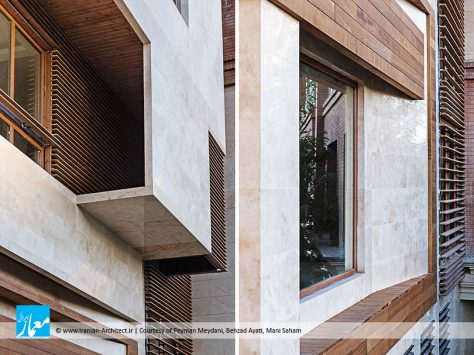
با توجه به اصرار کارفرما بر استفاده از حداکثر متراژ ممکن، امکان ایجاد فضاهای باز و نیمهباز در طبقات ممکن نبود. در این راستا، در بخشهایی از حجم که عوامل دیگر اجازه وقوع این اتفاق را میدادند، پوسته خارجی در قالب فضای نیمهباز و سبز ظاهر شده است. علاوه بر گلدانهای زیر پنجرهها، فرم ایجاد شده توسط این جداره بر روی بام، به عنوان حیاطی سبز و در عین حال خصوصی مورد بهرهبرداری قرار گرفته است. در این بخش سعی شده است که علاوه بر قاب کردن دید کوهستانهای شمال و منظر شهر در سمت جنوب، نور غرب و دید ساختمان بلند شمالی کنترل شود.
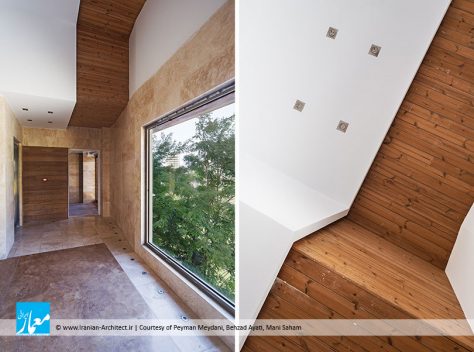
ساختمان سروین شامل ۵ طبقه اداری، با متراژ ۲۴۴ مترمربع در هر طبقه، یک طبقه تجاری در تراز همکف و نیمطبقه، با متراژ ۳۵۰ مترمربع، و ۵ طبقه پارکینگ زیرزمین، با متراژ ۲۹۵ مترمربع است. سیستم تاسیساتی مورد استفاده، وی. آر. اف و سازه بنا، اسکلت فلزی است. دستاورد این طرح، تجربهای است که پتانسیلهای استفاده از پوستهای با هویت نسبتا مستقل از بنا را در هماهنگسازی نیروهای داخلی و خارجی و کنترل کیفیت ارتباط بیرون و درون عیان میسازد. ادعای ما، بالفعل کردن همه این پتانسیل نبوده و صرفا با تاکید بر وجود آن، سعی در برداشتن قدمی در راستای بازتعریف ارتباط بنا و پیرامونش داشتهایم.
Sarvin Group Building
Peyman Meydani, Behzad Ayati, Mani Saham
راهیافته به مرحله نیمهنهایی سومین دوره جایزه شایستگی معمار ایرانی (۱۳۹۹)
Semi-Finalist of Iranian Architect Merit Award 2020
Location: Tehran, Iran
Date: 2013
Area: 3130 sqm
Status: Completed
Client: Farhad Joulani
Project Team: Mahboubeh Yousefikhah, Mohsen Haghparast, Parihan Rashidi, Marzieh Nabizadeh
Sarvin office-commercial building is located at the intersection of Makoueipoor and Behzadi streets. Adjacent to the Velenjak (Tochal) flood-way which has been designed and reconstructed as urban green area, the particular position of this project requires focusing design on the connection between the building and the external space. We were trying to acquire a model for connecting the building interiors with the exterior space or the city. Such model would introduce the best resultant of the effective interior and exterior forces and have the capability of advancing in the city as well as shaping the urban sights.
In addition to being situated at a busy intersection with axes that enable the distant view of the building, the office-commercial usability of the building together with the necessity of visibility and external appearance left the door open to enhance the relation between the interior and the exterior, so that the desired concepts would be expressed within a more liberal context. Using specific details, this model was realized as a form-based experience to obtain modern methodologies for connecting the building to the city. This idea then emerged as a separate surface of the interior space. The formation of this layer was founded on rational hypotheses considering the most essential circumstances affecting each architectural form. In this regard, the factors were defined in the form of three general categories, namely “climatic solutions”, “particular usability (office-commercial)”, and “visual relation from and to the city”.
The major forming factors which basically made the main body were both the desired look to the urban natural sight from inside the building at particular angles, and the external view to the building from the important urban flow axes at the building location. The internal sections in the surface cracks have been represented by making changes to the materials and by using wood as a manifestation of the perceptional interior life. This special combination of stone in the outer layer and wood in the inner layer of the architecture surface was an example of the design key vocabularies. The unification of the interior and exterior spaces in the entrance of the building makes this relation even more enduring, by combining the form and the materials. This point, like other external and internal contact points and more forceful than all of them, plays a key role in maintaining such relationship. The input positioning has considered this point in developing the plan as well and has been such assigned to be accordance with both the natural and urban point of views in the building connection point.
The demand for external emergence and urban visualization for office-commercial purposes too has had impact on changing the form of this surface. By harmonizing the symbols and informative layers with the observer point of view and movement, both on foot or by any transport, such demand has brought the architecture to the human scale and therefore, has retained the relationship at such level as well. Among the climatic factors, the wind flow which would intensify due to the position of the building at the side of the valley river has been effective in shaping the surface form next to the upper level windows. Moreover, the existence of a pleasant view at the west front as well as the opening of the surface in this section, have made vital the need for the adjustment of the west light and this too has been made possible by changing the surface form.
Due to the client insistence on utilizing the maximum possible area, development of open and semi-open spaces in the floors was not feasible. Nevertheless, in sections of the volume where other factors would allow the occurrence of such incident, the external surface has appeared in a green and semi-open space template. In addition to the vases under the windows, the form created by this wall on the roof has been employed as a green and yet private yard. In addition to framing the view of the northern mountain as well as the city sight in the south, it has been tried in this section to control the west light and the northern tall building view.
Sarvin building consists of 5 office floors with an area of 244 square meters per floor, one commercial floor in the ground level, a semi-floor with 350 square meters, and 5 floors allocated to the 295 square meters basement parking lot. The mechanical system being used is VRF and the structure of the building is made of steel. The outcome of this design is an experience that visualizes the potentials of using the surface, with an identity relatively independent of the building, in harmonizing the internal and external forces as well as in the quality control of the interior connection to the exterior. Our claim was not to activate all of these potentials but with focusing merely on its existence, we tried to take a step towards the redefinition of the building relationship with its surroundings.

